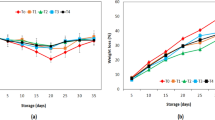Abstract
The work aims at the production and formulation of plant-based nutritionally enriched butter-like spread products using chia seed, sesame seed, watermelon seed, and pumpkin seed in different ratios, with incorporation of olive oil. The formulated spread butters COB (chia + olive oil), CSOB (chia + sesame + olive oil), CWOB (chia + watermelon + olive oil), and CPOB (chia + pumpkin + olive oil) are of superior quality due to its antioxidant and nutrient content. The antioxidant property of all the formulated spread butter is characterized by total phenolic content (TPC), DPPH free radical scavenging activity, and FRAP assay and the results indicated that CSOB has the highest TPC value of 68.73 ± 0.01 µg GAE/ml and CWOB has the highest DPPH and FRAP activity of 52.30 ± 0.01% and 51.01 ± 0.01 µg of AAE/ml, respectively. The physicochemical properties of all the formulated butter was also analyzed via acid value, peroxide value, and totox value and the results were satisfactory with CPOB having the lowest Totox value of 2.25 ± 0.01. Functional properties of the spread butter are also investigated and the results were satisfactory. All the formulated butters are medicinally and nutritionally beneficial, and it can be used as an alternative to the conventional one.




Similar content being viewed by others
Data Availability
The authors confirm that the data supporting the findings of the study are available within the article.
References
Eaton, S. B., and Konner M. (1985). Paleolithic nutrition : a consideration of its nature and current implications. New England Journal of Medicine, 312: 283-289. https://doi.org/10.1056/NEJM198501313120505.
Tabiri, B. (2016). Watermelon seeds as food: nutrient composition, phytochemicals and antioxidative activity. Journal of Nutrition and Food Sciences. 5(2):139. https://doi.org/10.11648/j.ijnfs.20160502.18.
Sayed, A. Q., Akram, M., Shukat, R. (2019). Nutritional and therapeutic importance of pumpkin seeds. Biomedical Journal of Scientific and Technical Research, 21 (2). https://doi.org/10.26717/BJSTR.2019.21.003586
Kapoor, S. et al. (2015). Sesame, 37–45. New York: Springer.
Fares, N. (2016). Physical chemical and sensory characterization of olive oil of the region Kairouan. Journal of Materials and Environment Science, 7(6): 2148-2154.
Lowry, O. H. (1951). Protein measurement with the folin phenol reagent. Journal of Biological Chemistry, 193(1): 265-275.
Ghosh, N., Bhattacharyya, D. K. (2019). International Journal of Pharmacy and Pharmaceutical Sciences, 11(9):87–89. https://doi.org/10.22159/ijpps.2019v11i9.32917.
Ahmas, S., Roselina, K., Hasanah, M. G., Nyuk, L. C. (2013). Rheological and sensory properties of oxidative stability of nut spread – a review. International Journal of Molecular Sciences, 14: 4223-4424.
American Oil Chemists’ Society. (1997). Official methods and recommended practices of the american oil chemists’ society, 4th edn., ed D. Firestone. Champaign, Method Cd 8-53.
Hathorn, C. S., Sanders, T. H. (2012). Flavour and antioxidant capacity of peanut paste and peanut butter supplemented with peanut skin. Journal of Food Science, 77(11): 5407-5411 https://doi.org/10.1111/J.1750-3841.2012-02953.x.
Ghosh, N., Bhattacharyya, D. K. (2020). Isolation characterization and determination of antioxidative properties of protein extracted from rohu (Labeo rohita) fish skin. Asian Journal of Pharmaceutical and Clinical Research, 13(3): 79–83. https://doi.org/10.22159/ajpcr.2020.v13i3.36615.
Benzie, I. F., Strain, J. J. (1996). The free rudicing ability of plasma (FRAP) as a measure of antioxidant power the ‘FRAP’ assay. Analytical Biochemistry, 239(1): 70-76.
Kain, R. J. and Chen, Z. (2008). Effects of processing methods on the physicochemical functional parameters of peanut flour (Arachis hypogaea L). Biotechnology, 7: 168–174. https://doi.org/10.3923/biotech.2008.168.174.
Acknowledgments
The authors are grateful to SOCSAT lab, IIEST, Shibpur, for giving necessary funding and facility to carry out the work.
Funding
Funding is provided by the SOCSAT lab, IIEST, Shibpur.
Author information
Authors and Affiliations
Contributions
All the three authors have contributed equally for the research work. Nabanita Ghosh is the Senior Research Fellow and co PI of the work, Swati Singha is the intern of the work, and Moumita Ghosh is the PI of the work.
Corresponding author
Ethics declarations
Ethical Approval
Not applicable
Consent to Participate
Not applicable
Consent to Publish
Not applicable
Competing Interests
The authors declare that they have no competing interests.
Additional information
Publisher’s Note
Springer Nature remains neutral with regard to jurisdictional claims in published maps and institutional affiliations.
Rights and permissions
About this article
Cite this article
Ghosh, N., Singha, S. & Ghosh, M. Formulation and Characterization of Chia (Salvia hispanica) Seed Spread with Incorporation of Sesame (Sesamum indicum) Seed, Watermelon (Citrullus lanatus) Seed, and Pumpkin (Cucurbita pepo) Seed. Appl Biochem Biotechnol 193, 1898–1908 (2021). https://doi.org/10.1007/s12010-021-03499-8
Received:
Accepted:
Published:
Issue Date:
DOI: https://doi.org/10.1007/s12010-021-03499-8




